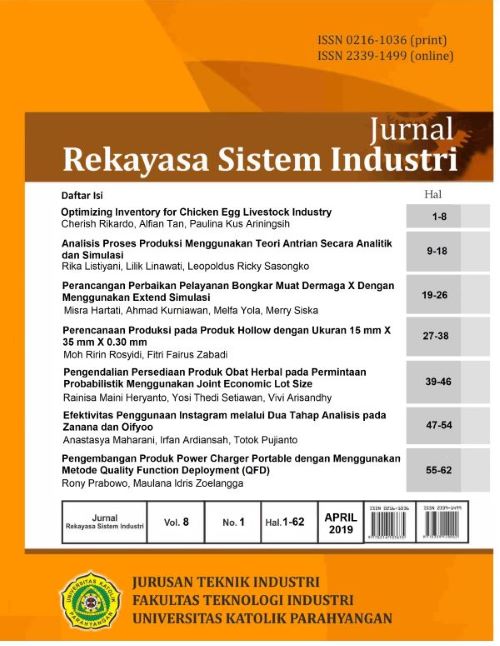Analisis Proses Produksi Menggunakan Teori Antrian Secara Analitik dan Simulasi
DOI:
https://doi.org/10.26593/jrsi.v8i1.3154.9-18Abstract
The focus of this research is to analyze the production process queuing system at one of the stages of production of swiftlet nest in analytical and simulation. The purpose of this research is to obtain the model and characteristics of the queue system at the Finishing-2. The analysis uses data on the rate of arrival and the rate of service based on real observation and determines the probability distribution of data between arrival time and service time using the Easyfit 3.0 program, to get the model of the queuing system is obtained. After the model obtained, analytic and simulation analysis is carried out using the Queuing System Simulation (QSS) module in the WINQSB software. The results of the queuing system characteristics in the analytical and simulation have a significant difference, because the distribution of time between arrivals and service times used in analytical calculations is G (general), while the simulation uses a distribution that refers to a particular type of distribution according to the results of the Easyfit program. Simulation is carried out with the FIFO and SIRO queue disciplines. The simulation results show that 91% of the characteristics of the queue system in the two queue disciplines do not have a significant difference. Moreover, it has also been done a comparison between the characteristics of the queuing system in two different work areas namely Room A and Room B&C, based on the simulation results, the results show 58% of the characteristics of the queuing system have a significant difference, this is due to differences in service time between the two work areas. Thus the purpose of this research has been achieved which is obtained by the queue model (G/G/c):(FIFO/∞/∞), and also obtained system performance improvements, in the form of waiting time in the queue where the waiting time in Room B&C is smaller than Room A.
Keywords: Queuing, Arrival, Service, Production, Simulation.
References
Artiguna, P.P., Sugito, & Hoyyi, A. (2014). Analisis Sistem Antrian pada Layanan Pengurusan Pasport di Kantor Imigrasi Kelas I Semarang. Jurnal Gaussian, Vol. 3( 4), 801-810.
Lieberman, Hillier. (2008). Introduction to Operation Research (8th ed.). Inc. New York: The McGraw-Hill Companies.
Mikowati, Linda. (2010). Analisis Sistem Antrian pada Industri Pengolahan Roti (Studi Kasus di PT Nippon Indosari Corpindo). Skripsi. Jurusan Matematika Fakultas Teknologi Petanian. Institut Pertanian Bogor.
Setiawan, A., (2017). Analisis Data Statistik. Salatiga: Tisara Grafika.
Shortle, J.F dkk. (2018). Fundamentals of Queueing Theory (5th ed.). Inc: John Wiley and Sons.
Siagian, P. (2006). Penelitian Operasional, Jakarta: Penerbit Universitas Indonesia (UI-Press).
Sugiyono, Susanto, A. (2015). Cara Mudah Belajar SPSS dan Lisrel Teori dan Aplikasi untuk Analisis Data Penelitian. Bandung: Alfabeta.
Taylor III, B.W. (2004). Introduction to Management Science (8th ed.). Upper Saddle River, New Jersey: Pearson Education-Prentice Hall,.
Wibowo, A., Ramadian, D. (2010). Model Simulasi Kinerja Produksi Teh untuk Minimisasi Work-In-Process, Jurnal Optimasi Sistem Industri, Vol. 9(1), 7-12.

